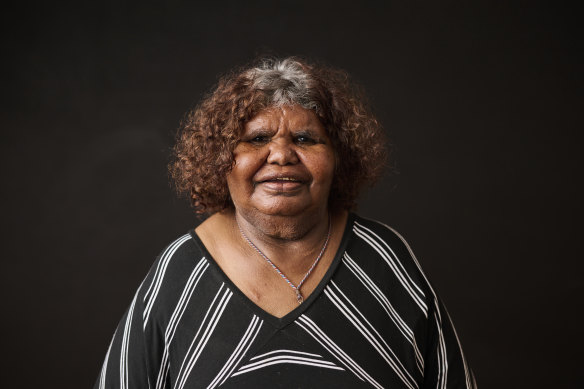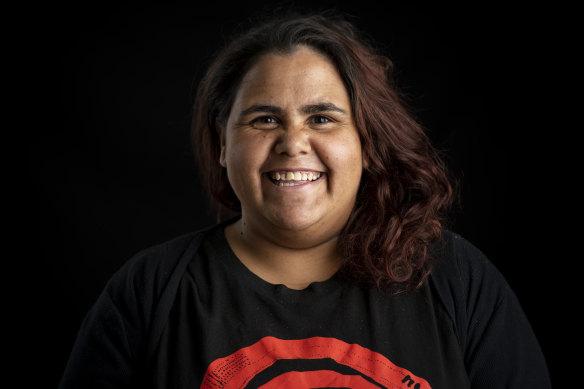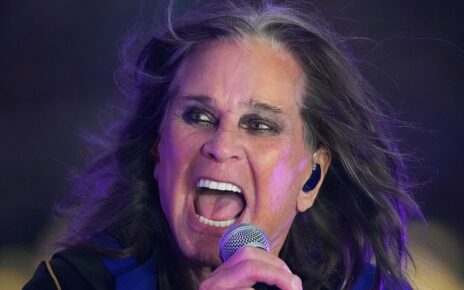Save articles for later
Add articles to your saved list and come back to them any time.
After two lengthy investigations into the integrity of its artwork, the Indigenous-owned APY Art Centre Collective faces further scrutiny – a development that has stunned its artists and staff.
A South Australian government-led review of various allegations, including that APY collective staff intervened in the work of Indigenous artists, came back with no findings last week and has instead referred the centre to the Office of the Registrar of Indigenous Corporations (ORIC) and the Australian Competition and Consumer Commission (ACCC).
Artist Yaritji Young rejects any suggestion she’s been told what to paint.Credit: Rohan Thomson
The result has devastated the artists and staff of the APY Art Centre Collective who had hoped to end the year with its reputation restored.
“Our frustration is that we have been continuously examined since Easter this year, robust examinations, examinations that really hurt artists and staff because there are constant questions being asked about our integrity as arts professionals,” says the collective’s general manager Skye O’Meara.
“The can has been kicked further down the road by government, which is devastating for us.”
When asked by this masthead on what grounds the collective had been referred to ORIC and the ACCC given that no findings had been made, South Australian Arts Minister Andrea Michaels said in an email: “The review panel interviewed more than 200 people and received sufficient information relating to the allegations that they determined it warranted referrals to the ACCC and ORIC.”
The review was conducted by Adelaide lawyer Anne Sibree; Menang woman and director of the National Suicide Prevention and Trauma Recovery Project Megan Krakouer; and Quandamooka man and deputy chair of the Queensland Tourism Industry Council Cameron Costello.
“The panel did not have powers to compel information, and accordingly has referred relevant information to investigative agencies with greater information-gathering and witness protection powers,” Michaels said.
However, in a confidential letter sent to the collective, which has been seen by this masthead, the reviewers wrote: “The panel wants to clearly emphasise that it is not its job to make, and has not made, any findings or is inferring or determining guilt or innocence of the APY ACC on matters referred.”
They further noted: “The sector is a highly commercial and competitive environment and there have been instances in the past where referrals have been weaponised to inflict damage, reputational or otherwise, to parties.”
Sally Scales says the collective is the “most scrutinised arts organisation in the country”.
Artist Sally Scales, who paints at the collective’s Adelaide studio, commended the reviewers’ work, particularly Krakouer, who she said “fully understood and respected the trauma that we’ve been in this year”.
But Scales added: “We’re the most scrutinised arts organisation in the country, not First Nations, just arts organisation. How many times do me and my elders have to go through this rigmarole? How many times do we have to justify our successes … do people think that we’re dumb blacks from the bush?
“The strength of my elders and the strength of their resolve is incredible. They’re like, we’ve got stuff to get on with. They all want to continue in their artistic practice. Let’s not forget that art centres are the only source of non-government money on remote communities. These are artists that are living on the poverty line and whose artworks help support families and put food on the table for those families.”
It has been the worst year on record for the collective.
The group, which represents more than 500 artists across the vast APY Lands of South Australia, as well as 60 artists in Coober Pedy and 30 in Port Augusta, had been riding a wave of success. Its artists celebrated nationally and internationally include Vincent Namatjira, Betty Muffler, Tuppy Goodwin, Iluwanti Ken and this year’s Wynne Prize winner Zaachariaha Fielding.
But that all came to a crashing end following the publication in April of a seemingly damning video showing a white studio assistant laying base layers of paint on the canvas of senior law woman and artist Yaritji Young.
After taking a hit earlier this year, art sales had picked up again and were doing well, O’Meara said.
“I think it’s fair to say that it paralysed the marketplace for a period of time and that’s something that impacted not only us and the APY Lands but Indigenous artists all over the country, which is why we trusted the [SA] state government when they committed to finding a fast resolution.”
The Office of the Registrar of Indigenous Corporations confirmed it had received the referral from the South Australian government.
“We will assess that referral and determine whether there are possible breaches of the CATSI [Corporations Aboriginal and Torres Strait Islander] Act,” a spokesperson said. “There are offences under the CATSI Act that do carry potential penalties, financial or imprisonment, but that would be a matter for a court to decide.”
When asked whether the video of a white studio assistant painting base layers onto the canvas of Yaritji Young might constitute a criminal act, the spokesperson said: “That’s not a governance matter, ORIC investigates matters of governance.”
The Australian Competition and Consumer Commission was also contacted but did not respond by deadline.
Earlier this year the National Gallery of Australia found there had been no improper interference in the making of 28 paintings that had been destined for the Ngura Pulka (Epic Country) exhibition. The exhibition has been indefinitely postponed.
The Booklist is a weekly newsletter for book lovers from books editor Jason Steger. Get it delivered every Friday.
Most Viewed in Culture
From our partners
Source: Read Full Article




